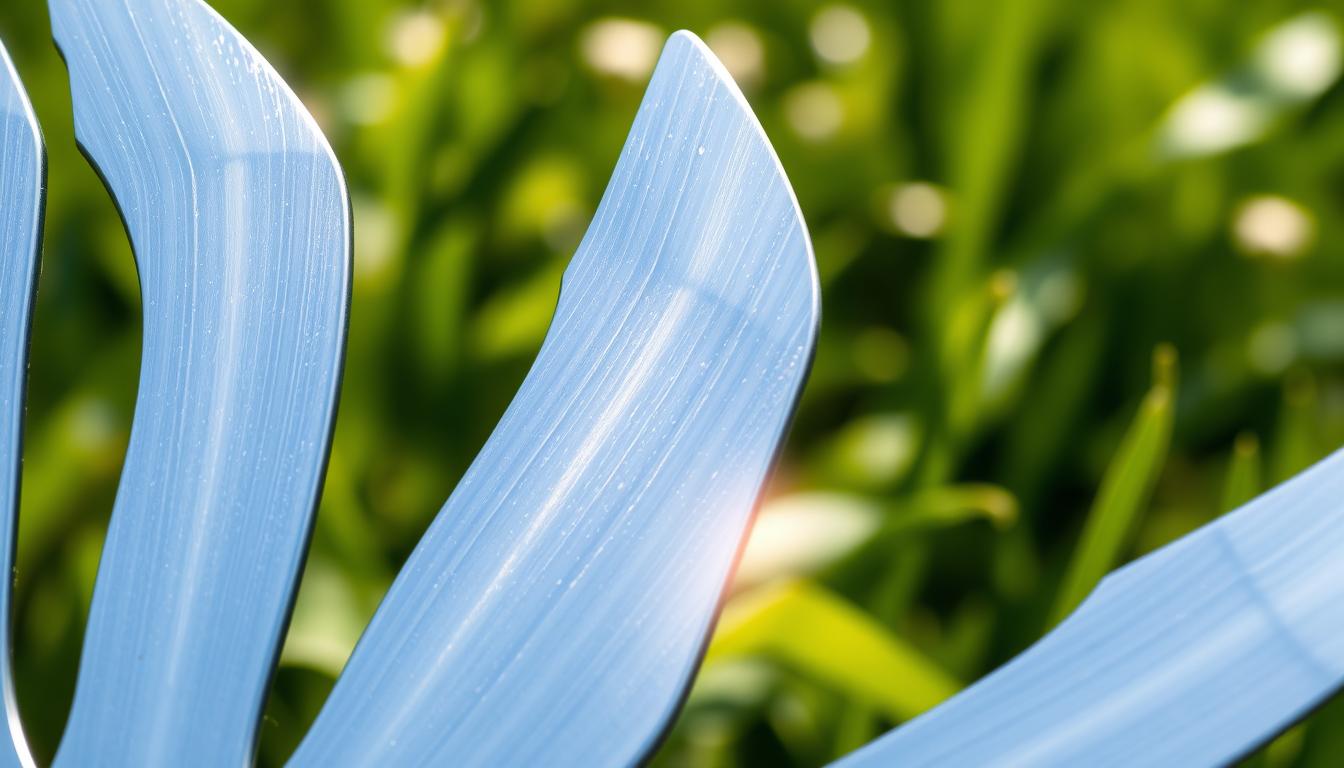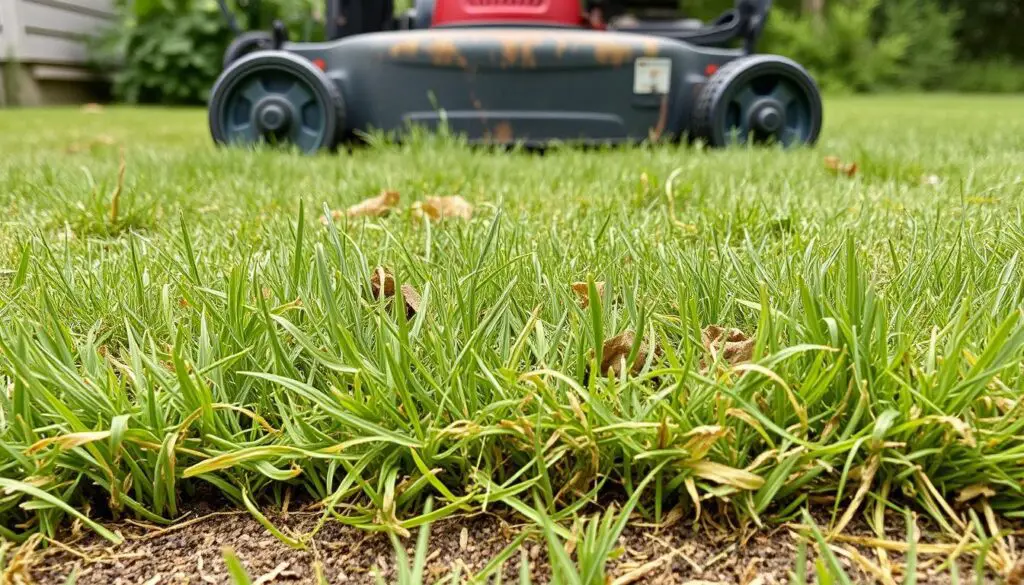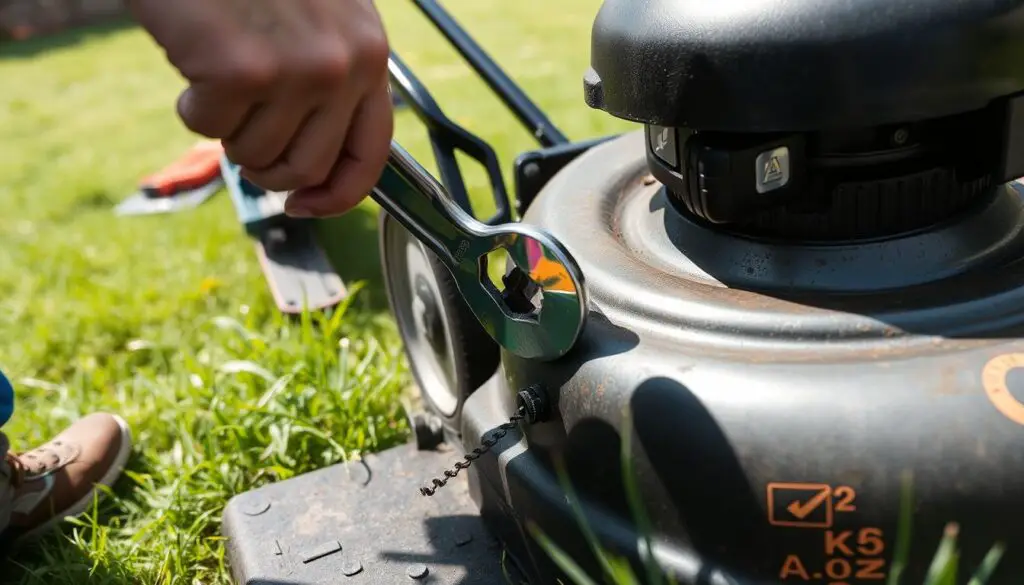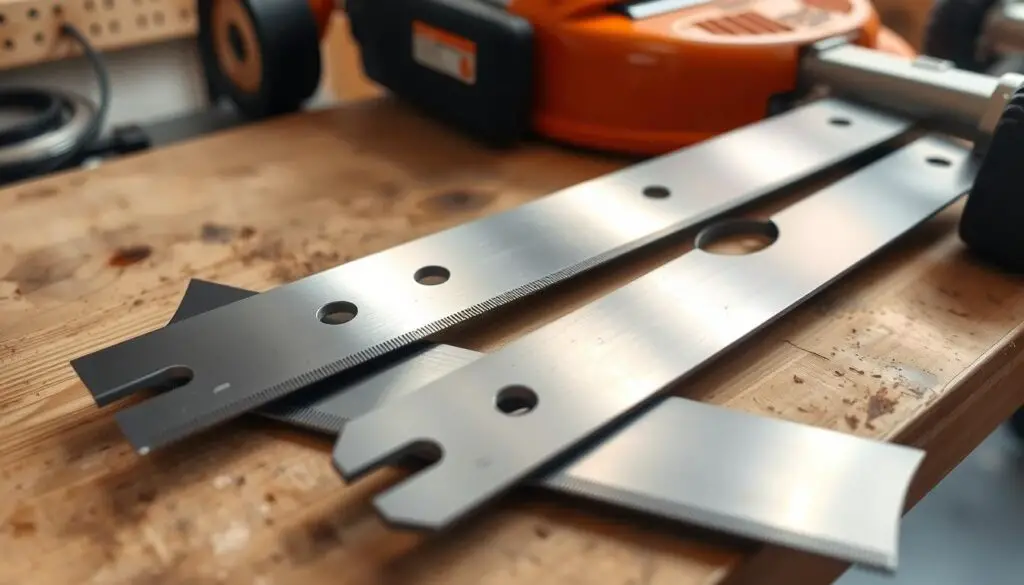How to Sharpen Lawn Mower Blades A Step-by-Step Guide

Did you know that lawn mower blades need sharpening every 25 hours of use? Keeping your mower blades sharp is key for a clean cut and healthy grass. This guide will teach you how to sharpen your mower blades. You’ll learn about the importance of sharp blades, when to sharpen them, and the tools and techniques needed.
Whether you have a push mower or a riding lawn mower, these tips will help your grass look great all season.
Key Takeaways
- Lawn mower blades should be sharpened at least every 25 hours of use for optimal performance.
- Sharper blades promote healthier grass growth and reduce the risk of disease or pest infestation.
- Regular blade maintenance can help prevent potential damage to the mower by reducing the workload on the engine.
- Proper blade sharpening techniques, including checking for damage and balancing the blades, are crucial for ensuring an even cut.
- Following safety protocols, such as disconnecting the power source and wearing protective gear, is essential during the sharpening process.
The Importance of Sharpening Lawn Mower Blades
Keeping your mower blades sharp is key for a healthy lawn. Dull blades tear the grass, making it weak to diseases and uneven. Experts say to sharpen blades twice a year, or more if you mow often.
Maintaining a Sharp Blade for a Healthy Lawn
Sharp blades give your lawn a clean, even cut. Dull blades can cause brown spots and uneven growth. They also help prevent weeds by cutting the grass cleanly.
Improved Mowing Efficiency and Reduced Wear
Sharpening your blades regularly makes your mower last longer. Sharp blades need less effort, which means less strain on the engine. Dull blades, on the other hand, can dry out the grass, making it vulnerable to pests and diseases.
Regular blade maintenance is a small step for a big difference in your lawn. Sharp blades mean a weed-free, professional-looking yard with less wear on your mower.
Signs Your Lawn Mower Blades Need Sharpening
Keeping your lawn mower blades sharp is key for a healthy lawn and efficient mowing. Over time, even the strongest blades can dull, causing problems. Here are signs it’s time to sharpen your mower blades:
- Uneven or ragged grass after mowing: Dull blades tear the grass, leaving it looking bad.
- Torn or shredded grass blades: Sharp blades cut grass cleanly, but dull ones rip it, making it look unhealthy.
- Decreased cutting efficiency: If your mower works harder and longer, dull blades are likely the cause.
- Strange noises or vibrations: Worn or unbalanced blades can make your mower sound odd or vibrate.
Regularly check your lawn and mower’s performance to spot dull mower blades. By being quick to address sharpness issues, you can keep your lawn looking great and your mower running well.

“It’s recommended to sharpen lawn mower blades every 20 to 25 hours of use, with the option to replace blades without excessive cost.”
Preparing to Sharpen Mower Blades
Before sharpening your lawn mower blades, make sure you have the right tools and materials. Also, disconnect the power source safely. This preparation is key to sharpening your mower blades well and avoiding accidents.
Gathering the Necessary Tools and Materials
You’ll need some important items to sharpen your mower blades. These include work gloves, safety glasses, a wrench or socket set, a file or grinder, and a blade balancer. Having these tools ready will make sharpening safer and easier.
Safely Disconnecting the Power Source
It’s very important to disconnect the power source before touching the mower blades. This could be a battery, cord, or spark plug wire. It prevents the mower from starting up while you’re sharpening, keeping you safe from injury. Make sure to disconnect the power source correctly and confirm the mower is off before starting.
By preparing well and having the right tools, you’re ready to sharpen your lawn mower blades safely. Always remember, safety comes first when working with power equipment.
| Tool | Purpose |
|---|---|
| Work gloves | Protect your hands from sharp blades and edges |
| Safety glasses | Safeguard your eyes from debris and sparks |
| Wrench or socket set | Remove and reinstall the mower blades |
| File or grinder | Sharpen the blades to a clean, even edge |
| Blade balancer | Ensure the blades are properly balanced after sharpening |
Removing and Cleaning the Lawn Mower Blades
Keeping your lawn looking great is more than just mowing it. It’s important to remove and clean the mower blades regularly. This simple step can greatly improve your mower’s performance and lifespan.
First, safely take off the lawn mower blades. Tilt the mower to get to the underside. Find the bolt or nut that holds the blade in place. Use the right wrench or socket to loosen and remove it, then take off the blade. Proper lawn mower blade removal is key to avoid damage or injury.
Now, clean the blades well. Use a stiff-bristle brush or a rag to get rid of grass clippings, dirt, and debris. A clean blade sharpens better and cuts more evenly when put back on.
- Safely disconnect the power source before removing the blades.
- Locate and remove the bolt or nut securing the blade.
- Carefully clean the blades using a stiff-bristle brush or rag.
- Ensure all debris is removed to prepare for sharpening.
“A dull blade causes a whitish cast on the lawn, indicating ineffective grass cutting.”
By properly removing and cleaning the mower blades, you’re setting up for a successful sharpening. This lawn mower maintenance step keeps your mower in great shape. It ensures a clean, sharp cut every time you mow.

Inspecting the Blades for Damage
Before you sharpen your lawn mower blades, check them for damage first. Look for nicks, cracks, and bends. These can affect how well the blade works and might mean you need a new one instead of just sharpening it.
Identifying Nicks, Cracks, and Bends
Look closely at the blades for any nicks, cracks, or bends. Nicks can happen when you hit rocks or sticks while mowing. Cracks might show up over time from hitting the ground too many times. Bends can occur if the blade hits something hard or if the mower gets hit.
Checking for Blade Balance
It’s important for the blade to be balanced right. This helps you get a smooth cut and keeps your mower from vibrating too much. To check, hold the blade on a nail or screwdriver. If it’s not even, you’ll need to balance it after sharpening.
It’s best to sharpen your lawn mower blades every 20 to 25 hours of use. This keeps your cut sharp and helps your lawn stay healthy. If the blades are dented or bent, sharpening them is a must to avoid engine problems. A lawn that looks uneven or patchy might mean your blades need sharpening or replacing.
After sharpening, make sure to balance the blades again. This stops your mower from vibrating too much and keeps it in good shape. Always check your mower before use, including the spark plug and any loose or damaged parts.
| Recommendation | Frequency |
|---|---|
| Sharpen lawn mower blades | At least twice per season or after every 25 hours of use |
| Sharpen blades immediately after hitting a hard object | As needed |
| Inspect blades for wear, damage, or deep nicks and replace as needed | Regularly |
By checking your lawn mower blades for damage and making sure they’re balanced, you can keep your lawn looking great. And you’ll also make your mower last longer.
sharpen mower blades
Keeping your lawn mower blades sharp is key for a clean cut. There are many ways to sharpen them, each with its own benefits. Whether you like the control of manual blade sharpening or the speed of power tool blade sharpening, the right method makes a big difference.
Sharpening by Hand with a File
Using a metal file is a classic way to sharpen mower blades. It lets you fine-tune the blade’s edge for a sharp cut. Keeping the blade’s angle right helps it last longer. This method is perfect for those who enjoy doing things by hand and want full control.
Sharpening with a Bench Grinder
A bench grinder is a powerful tool for sharpening blades. It quickly brings back your mower’s cutting edge. But, be careful not to sharpen too much to avoid damage. It’s great for those with big lawns or many blades to sharpen.
Using a Drill-Powered Blade Sharpener
A drill-powered sharpener is easy and convenient. It attaches to your drill for quick sharpening. It’s ideal for homeowners who want to keep their blades sharp without extra effort.
Choosing the right sharpening method is important. Always keep the blade’s angle right and avoid over-sharpening. Regular sharpening means a clean cut and a beautiful lawn. For more tips, check out Better Homes & Gardens.

| Sharpening Method | Advantages | Considerations |
|---|---|---|
| Manual Blade Sharpening with a File |
|
|
| Power Tool Blade Sharpening with a Bench Grinder |
|
|
| Power Tool Blade Sharpening with a Drill-Powered Sharpener |
|
|
Balancing the Sharpened Blades
After sharpening your lawn mower blades, balancing them is key. An unbalanced blade causes vibration, damaging your mower and lawn. To balance, hold the blade on a nail or balancer and see how it settles. If it’s off, remove a bit from the heavy side until it’s balanced.
Keeping your lawn mower blade balance right is vital. Experts say sharpen blades at least once a year. Those who mow more often should sharpen two to three times a season.
Achieving Proper Blade Balance
To balance your blades, follow these steps:
- Support the blade on a nail or specialized balancer.
- See which side is heavier and grind or file a bit off that side.
- Check the balance again until the blade is perfectly balanced.
| Balancing Tool | Estimated Strokes for Proper Balance |
|---|---|
| Finish Nail | 5-10 strokes |
| Blade Balancer | 3-5 strokes |
Getting your lawn mower blade balance right is key. It reduces vibration and gives a clean cut. By balancing your blades, you’ll make your mower last longer and keep your lawn looking great.

Reinstalling the Sharpened Blades
Now that your lawn mower blades are sharp and balanced, it’s time to put them back. Make sure to align them correctly and tighten them properly. This ensures your mower works well and safely.
Proper Alignment and Tightening
Start by aligning the blades right, using any marks or notes from when you took them off. Make sure they’re centered and in the same spot as before. Then, tighten the blade holder securely, but don’t overdo it to avoid damage.
- Align the blades carefully, using any marks or notes from the removal.
- Tighten the blade retention mechanism (bolt or nut) securely, but do not over-tighten.
- Double-check that the blades are firmly in place and the mower is ready for its first post-sharpening test run.
By following these steps, you’ll ensure your lawn mower blade reinstallation is done right. The blades will be aligned and tightened for the best performance. Always keep safety in mind when working on your lawn mower. If you’re unsure, check the manufacturer’s instructions.
“Regular maintenance, including sharpening and proper reinstallation of your lawn mower blades, is key to maintaining a healthy, well-manicured lawn.”
Testing and Adjusting after Sharpening
After putting on new, sharp lawn mower blades, it’s important to test the mower. Mow a small part of your lawn and watch how it cuts. Listen for any odd sounds or vibrations. If the cut isn’t even or you hear strange noises, sharpen and balance the blades again.
Good blade sharpening means even grass cuts. If the grass is uneven or torn, the blades need more work. This could mean sharpening or adjusting them.
The mower should also run smoothly after sharpening. It should not vibrate or make unusual noises. If it does, check the blade’s alignment and the tightness of the hardware.
| Metric | Ideal Outcome | Troubleshooting |
|---|---|---|
| Mowing Quality | Even, clean cut | Repeat sharpening and balancing process |
| Vibration and Noise | Smooth operation | Check blade alignment and hardware tightness |
By testing and adjusting your mower, you’ll get the best from your sharp blades. This care will make your lawn look great and your mower last longer.
“Maintaining sharp mower blades is essential for the health and appearance of your lawn. It’s a small investment of time that can pay dividends in the long run.”
Maintaining Sharp Mower Blades
Keeping your mower blades sharp is key to a great lawn. I sharpen mine after 20-25 hours of use, or once or twice a season. This keeps my mower cutting well and lasts longer.
Having extra blades ready helps a lot. It lets me quickly change them when needed. This way, my mower works better and lasts longer.
If you don’t want to sharpen blades yourself, Mowers Guide has a solution. They offer sharpening services through local Toro dealers. Their pros will make your blades sharp again fast, so you can mow without hassle. With some effort and the right tools, sharp blades make your lawn look amazing.

